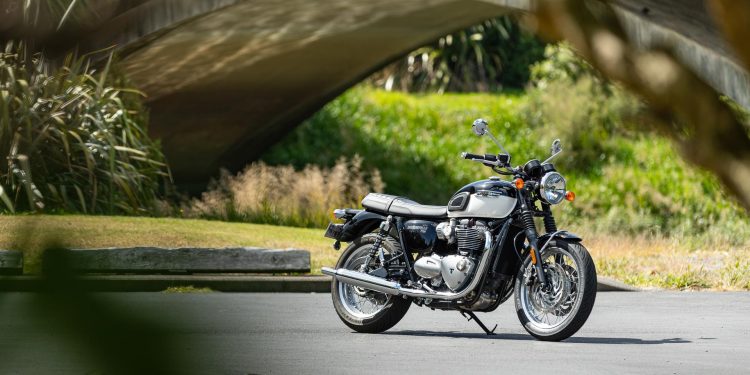2023 Triumph Bonneville T120 review
Words: Peter Louisson | Photos: Isaac Western
Near the head of Triumph’s long-serving Bonneville family is this 1200 twin, the T120. It’s T for terrific.
This was my first test ride of the summer and you forget just how hot it gets in leathers when you pull over to admire your ride. You quickly seek shelter to prevent par boiling.
Still, it’s worth it for some rides. And this would be one of those, this black and white beauty from Triumph.
Known as the Bonneville T120, it’s not a new bike per se but it was on Triumph’s fleet and when offered a spin there was not a moment’s hesitation from my end.
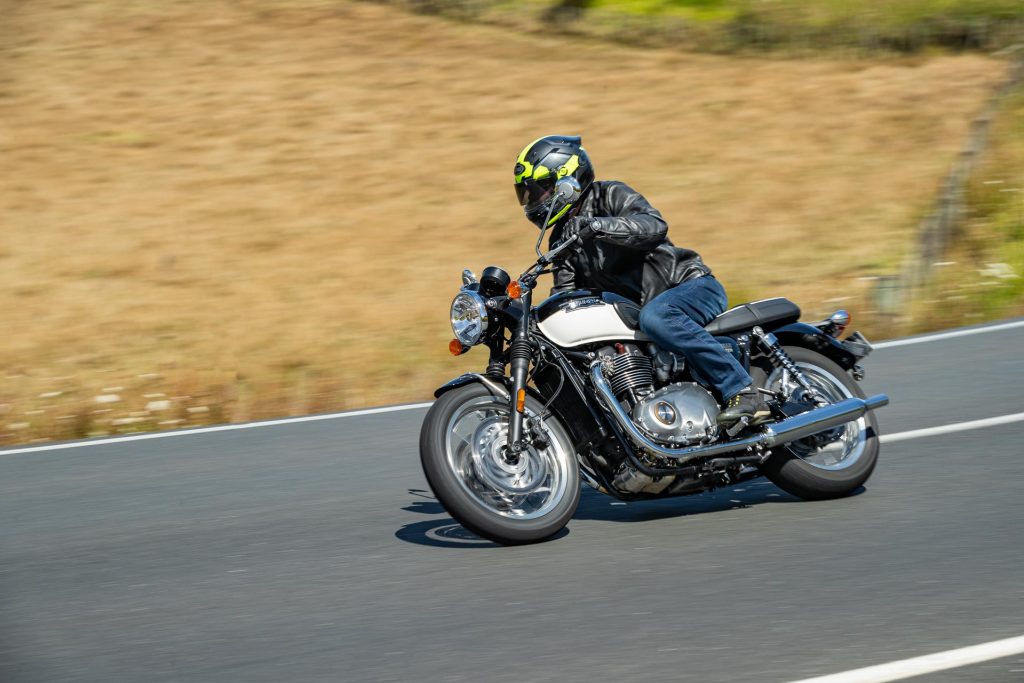
The last Bonneville we rode was the Triumph Bonneville T100 which proved well rounded in that back to basics way. The T120 is similar in that it does pretty much everything well, only it does it all with just a bit more of everything for not a great deal of added cost ($22,990 vs $18,490).
And who doesn’t want a 1200 if the alternative is under a litre?
Moreover, where the T100 has a single disc up front, this gets a pair of them. And naturally this has more squirt with the bigger engine.
But it’s more the extra low down torque the bigger mill possesses that you really notice. The 1200cc engine carries the HT suffix, standing for high torque. It pulls usefully from 1500rpm and with guts in the 2000s.
Best usable twist arrives at 3500rpm so upshifts at 4000rpm or so out of town and 3000 in the burbs have this humming along. Literally, we only revved it to the 6700rpm redline when performance testing.
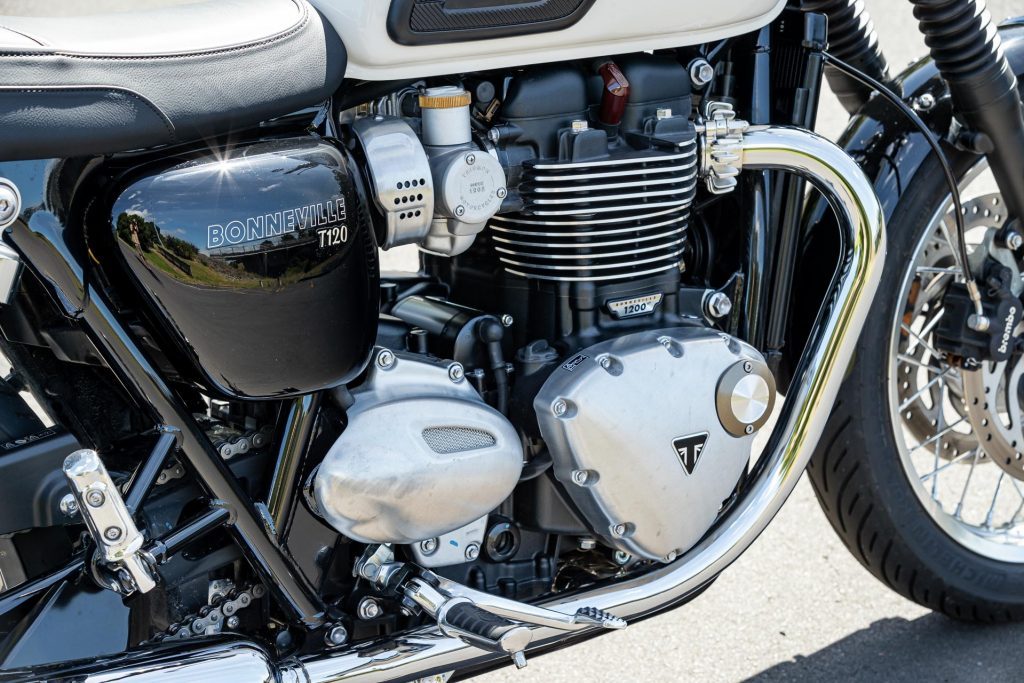
Then it managed a sprint to 100 in just a hair over four seconds, compared with 5.3sec for the T100, similar to the uptick seen for the overtake (2.7 vs 4sec).
And with another disc and caliper up front, the emergency stop from 100 was dusted in 36.74m, 2m better than the similar weight T100.
Easygoing, literally
Because it’s only ticking over at open road speeds (2600rpm) fuel use is exemplary, in the low fours on the motorway, despite a lack of wind protection.
So with a 14.5L tank you can expect up to 300km of travel before needing to refuel. In the latest update it became Euro5 emissions compliant too.
The peashooter exhausts are double skinned and make a lovely blat, thanks to the 270-degree firing order.
Engine operation is very smooth, with vibes only really apparent at higher revs which you seldom use anyway. At the 2021 update, Triumph carved off 7kg from the crank, making the engine more responsive.
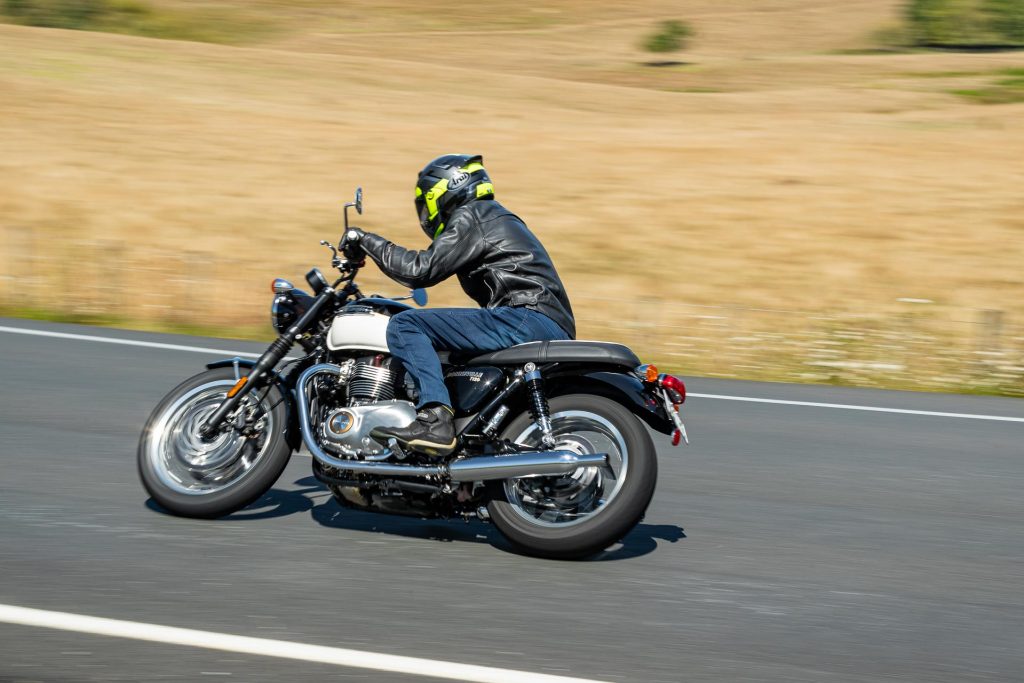
Riding it in Road mode gets the best from the mill. You have to be deliberate at backing right out of the throttle when slowing down, however, or it may run on, which can sometimes be a touch alarming.
The best of retro
The bike itself, technically, is a retro standard. So it’s styled like something from the sixties, but with modern tech underpinning it all. Except perhaps for the steel frame which is why it weighs more than if the chassis were composed of aluminium.
But it has items like ride-by-wire throttle enabling a pair of ride modes, easily switchable traction control and ABS for the Brembo/Nissin brakes (two-piston units for all three calipers).
You can think of this as cruiser-like in demeanour, it’s so laid back. Only it’s more comfy than most cruisers, despite suspension being adjustable only at the rear for preload where there are two traditional shocks.
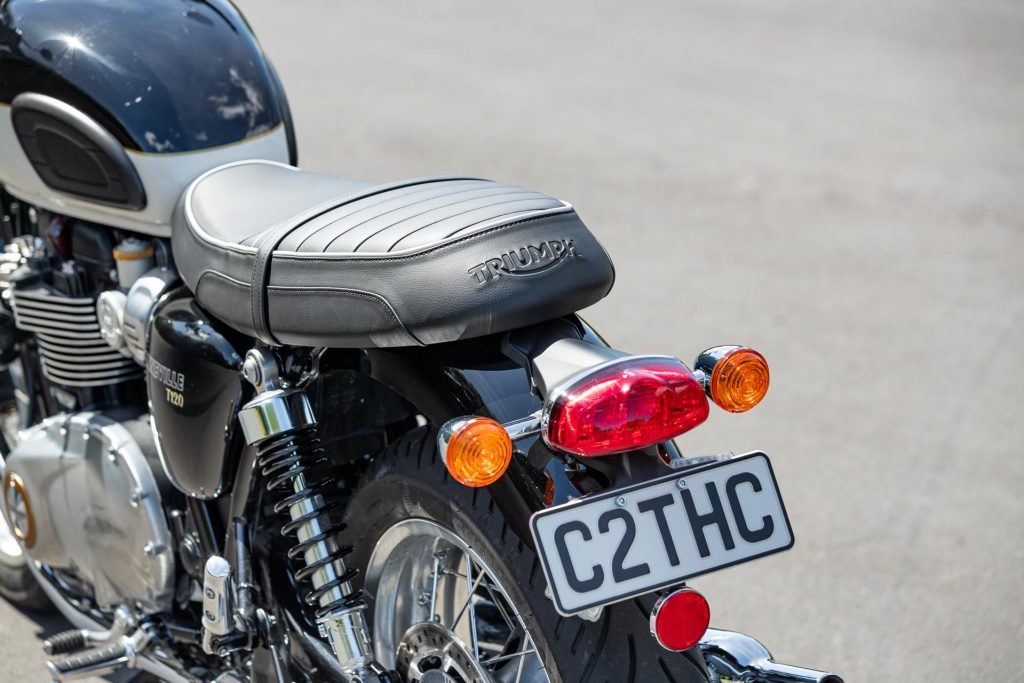
The dual seat might not look that comfy but it genuinely is, so too the suspension set-up, quashing bumps with ease.
And it handles well too. Sure, you can get it to touch down either side if you’re into the swing of things, but that’s only on tighter corners in the main. And you don’t really do that very much when cruising on this.
Not that it won’t hustle but you’ll be enjoying the ease and comfort of the ride more than wanting to scratch and grind. It steers easily, not too quickly, just perfect for purpose.
Evidently the new lightweight spoked wheels remove 7kg of unsprung weight for a breezier ride. So it’s agile but also it feels nicely planted, ideal for its cruisy manner. Even under emergency braking conditions this is unflustered.

And that’s the essence of this bike. It is about as easygoing as possible. Even gearbox action is fluid, especially for a big twin. And the clutch action is lightweight, a boon for commuting.
For cruising there’s a one-touch cruise control system. A push to get it working, another to set speed.
Simple, like all operations on this bike, except perhaps resiting the seat (after having removed it) which requires your tongue being in the right position.
Options, options
Things we don’t like about it are minor; there’s lots of brightwork about, especially around the instruments so they’re hard to make out in certain lights.
Pity because there’s good info there, including a permanently displayed distance to empty. I honestly cannot think of much else that isn’t quite right on this.
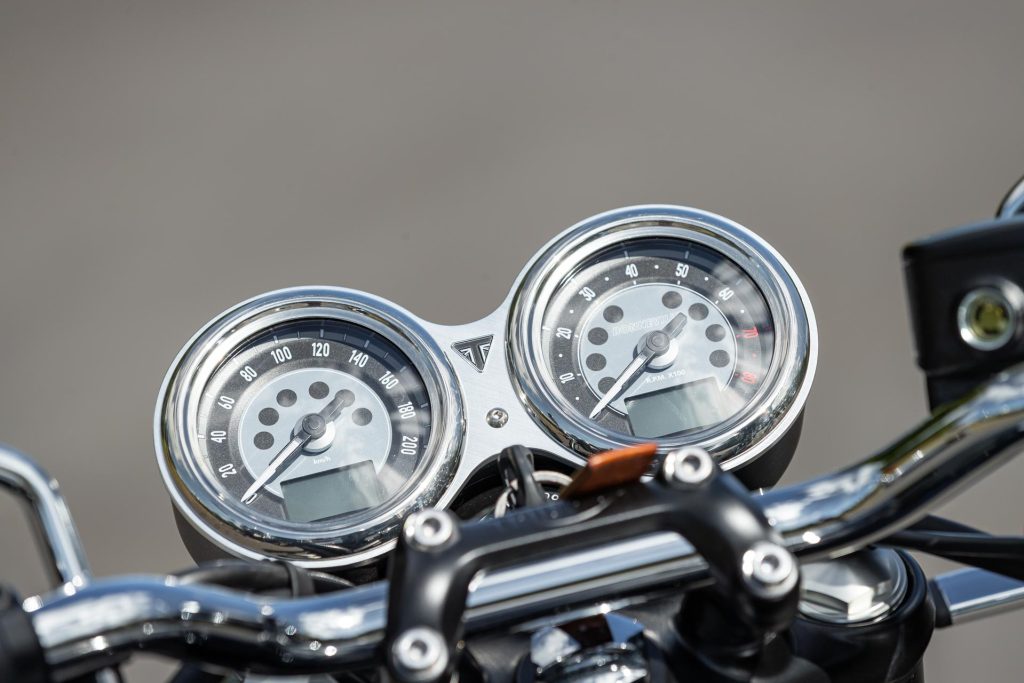
It’s one of those standard bikes that is just a joy to ride on a perfect windless still day. If it blows a lot around your way, you can always add a screen, one of the myriad accessories available for the T120.
There are nice colours too, and this year there’s the option of Stealth models, with tank colours fading to black. And these special edition T120s come at no extra cost!
Alternatively, you can settle for the two-tone of the standard machine, while there’s also a special DGR variant celebrating Triumph’s decade-long involvement in the Distinguished Gentleman’s Ride.
For an extra $500 you can go for the T120 Black which, oddly, has a brown seat cover, while for $1000 more there’s a T120 Chrome edition, with a blue tank merging into a chrome top.
All the T120s come with rubber knee pads on the tank, to keep the paint pristine, and to help with grip, though it is kind of narrow in the midriff.
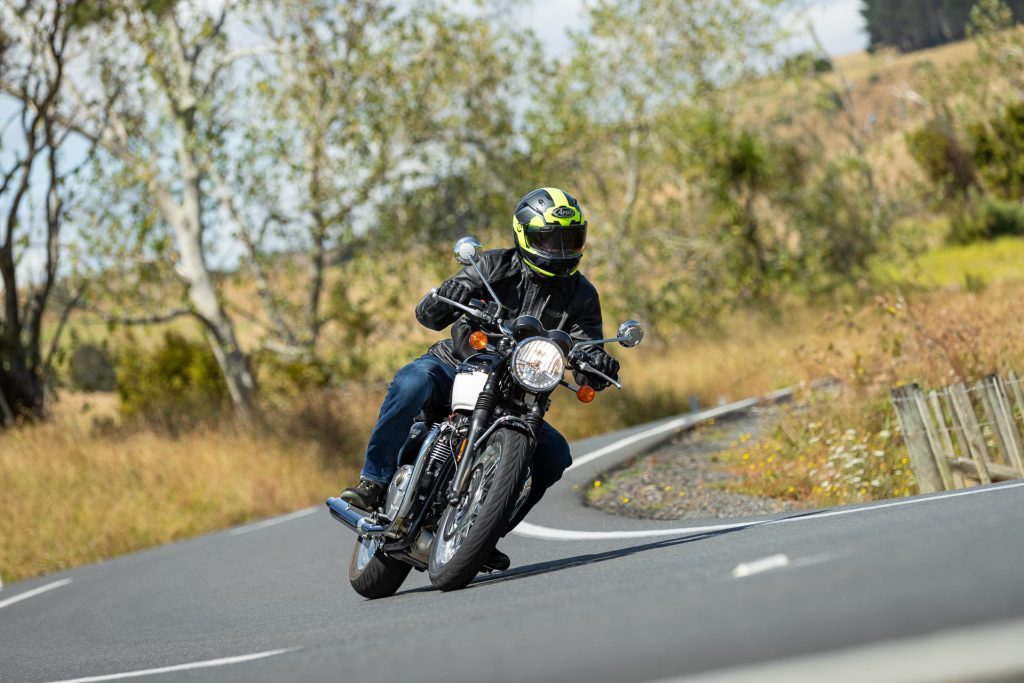
Fancy something a bit sportier? There’s always the Speed Twin 1200 with more urge, less weight and uprated Brembo brakes for the same price.
Or the slightly more expensive Triumph Speedmaster or Bobber, both $23,990, if you’re after more of a traditional cruiser/hardtail look.
| Model | Triumph Bonneville T120 |
| Price | $22,990 |
| Format | Liquid-cooled / fuel-injected / IL2 |
| Engine | 1198cc |
| Max Power | 59 kW @ 6550 rpm |
| Max Torque | 105 Nm @ 3500 rpm |
| Cylinder Head | SOHC / 8v |
| Gearbox | 6-speed |
| Drivetrain | Chain final drive |
| Front Suspension | 41mm forks, no adjustment |
| Rear Suspension | Twin shocks, preload adjustable |
| Front Brakes | Twin-piston calipers, 310mm disc |
| Rear Brakes | Twin-piston calipers, 255mm disc |
| Safety Systems | ABS, TC, wheelie control |
| Tyre Size | F – 100/90R18 / R – 150/70R17 |
| Tyres | Michelin Road Classic |
| Wheelbase | 1450mm |
| Seat Height | 790mm |
| Rake/Trail | 14.5 degrees / 105.2mm |
| Fuel Capacity | 14.5 L |
| Measured Weight | 236 kg |
| Weight Distribution | F – 113 kg / R – 123 kg |
This story first appeared in the April 2024 issue of NZ Autocar magazine.


